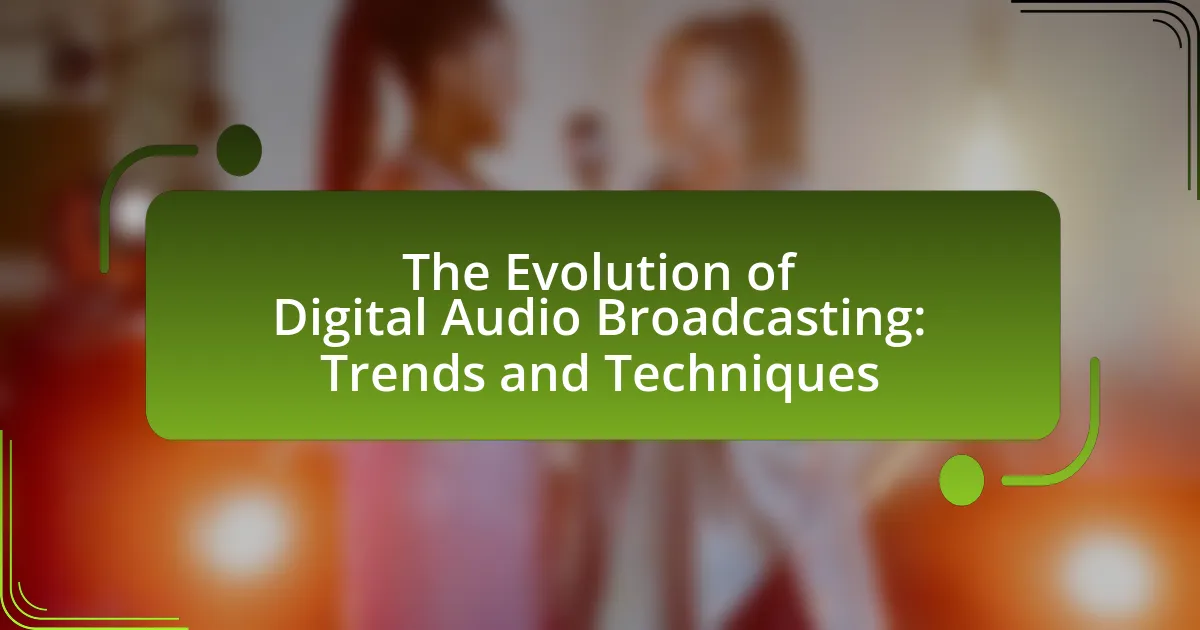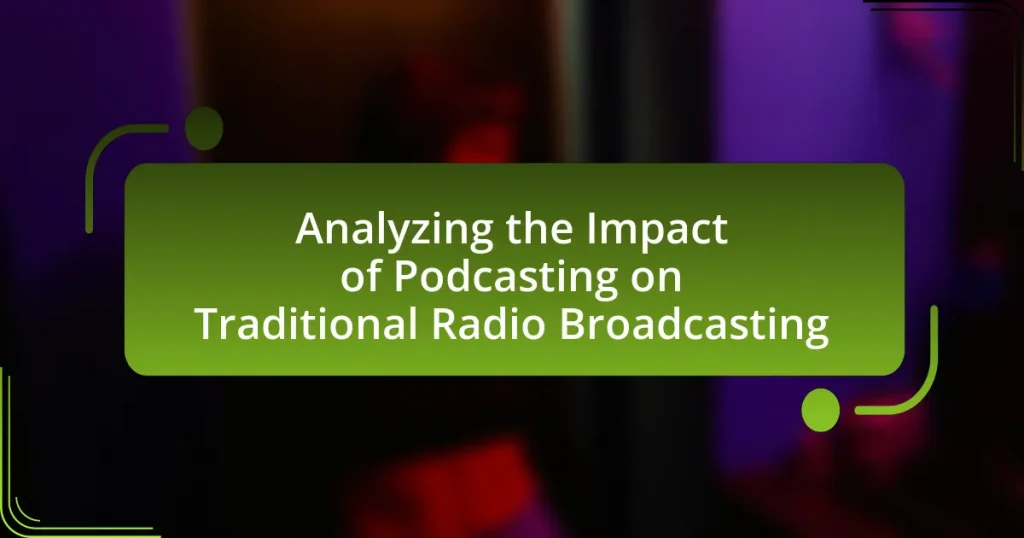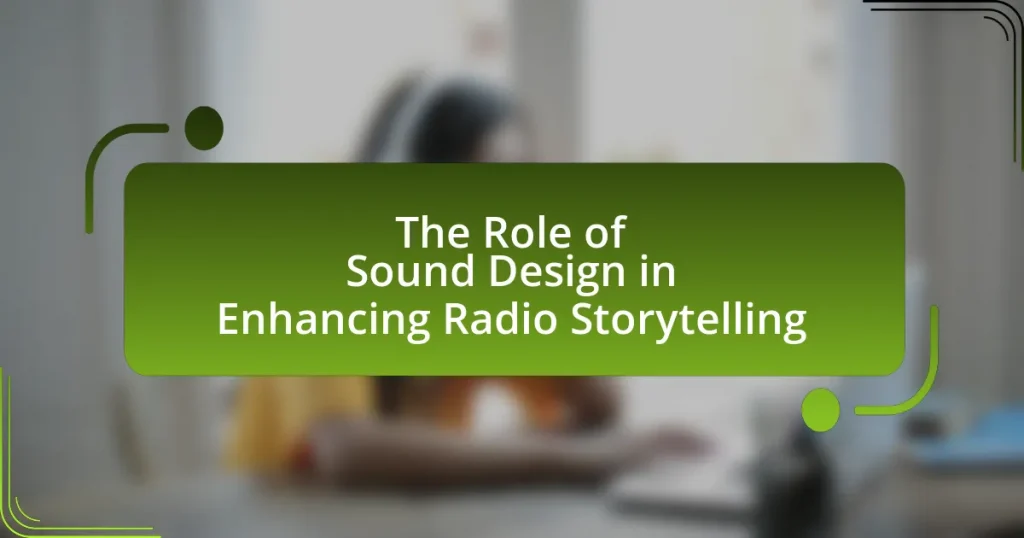Digital Audio Broadcasting (DAB) is a modern radio technology that transmits audio via digital signals, offering superior sound quality and the ability to deliver multiple channels within the same frequency. This article explores the evolution of DAB, highlighting its differences from traditional broadcasting, the technologies that support it, and the significant advancements that have shaped its development since its inception in the 1990s. Key trends such as hybrid radio, enhanced audio quality, and the influence of streaming services are examined, along with the challenges and innovations that impact the future of DAB. Additionally, the article discusses best practices for broadcasters and strategies to maximize audience engagement and audio quality.

What is Digital Audio Broadcasting?
Digital Audio Broadcasting (DAB) is a digital radio technology that transmits audio programming via digital signals instead of traditional analog methods. DAB provides improved sound quality, greater resistance to interference, and the ability to transmit multiple channels within the same frequency band, enhancing the listener’s experience. The technology was first introduced in the 1990s and has since been adopted in various countries, demonstrating its effectiveness in delivering high-quality audio and additional data services, such as song titles and artist information.
How does Digital Audio Broadcasting differ from traditional broadcasting?
Digital Audio Broadcasting (DAB) differs from traditional broadcasting primarily in its transmission method, utilizing digital signals instead of analog. This digital approach allows for higher sound quality, more efficient use of bandwidth, and the ability to transmit multiple channels within the same frequency. For instance, DAB can deliver additional data services such as song titles and artist information alongside audio, which traditional FM or AM broadcasting cannot provide. Furthermore, DAB is less susceptible to interference and offers better reception in challenging environments, enhancing the listener’s experience.
What technologies underpin Digital Audio Broadcasting?
Digital Audio Broadcasting (DAB) is underpinned by several key technologies, primarily the MPEG Audio Layer II and the DAB+ codec, which utilizes the AAC+ compression format. These technologies enable efficient transmission of high-quality audio signals over terrestrial radio frequencies. DAB employs a digital multiplexing technique that allows multiple audio channels to be transmitted simultaneously within a single frequency band, enhancing spectrum efficiency. Additionally, DAB utilizes error correction methods such as Reed-Solomon coding to improve signal reliability and quality. These foundational technologies collectively contribute to the advancement and effectiveness of digital audio broadcasting.
How has the transition from analog to digital impacted audio quality?
The transition from analog to digital has significantly improved audio quality by enhancing clarity, reducing noise, and allowing for greater dynamic range. Digital audio formats, such as PCM (Pulse Code Modulation), capture sound waves more accurately than analog methods, which are susceptible to distortion and degradation over time. For instance, digital recordings can maintain fidelity across multiple generations without loss of quality, unlike analog tapes that degrade with each copy. Additionally, digital audio allows for advanced processing techniques, such as equalization and compression, which further refine sound quality. Studies have shown that listeners often perceive digital audio as clearer and more detailed, supporting the notion that the shift to digital has positively impacted audio quality.
What are the key milestones in the evolution of Digital Audio Broadcasting?
The key milestones in the evolution of Digital Audio Broadcasting (DAB) include the initial development of DAB technology in the late 1980s, the first DAB broadcasts in the UK in 1995, and the establishment of the DAB standard by the European Telecommunications Standards Institute (ETSI) in 1996. In 2001, the first DAB receivers became commercially available, marking a significant step in consumer adoption. The introduction of DAB+ in 2007 improved audio quality and efficiency, allowing for more channels within the same bandwidth. By 2015, several countries, including Norway, began transitioning from analog to digital broadcasting, highlighting the growing acceptance and implementation of DAB technology globally. These milestones demonstrate the progression and increasing significance of DAB in the broadcasting landscape.
When did Digital Audio Broadcasting first emerge?
Digital Audio Broadcasting first emerged in the early 1990s, with the first experimental broadcasts taking place in 1995. The technology was developed to provide higher quality audio and more efficient use of the radio spectrum compared to traditional analog broadcasting. The European Union established the Eureka 147 project, which laid the groundwork for DAB standards, leading to its adoption in various countries starting in the late 1990s.
What significant advancements have shaped its development?
Significant advancements that have shaped the development of Digital Audio Broadcasting (DAB) include the transition from analog to digital transmission, the introduction of compression technologies like MPEG Audio Layer II, and the implementation of error correction methods such as Reed-Solomon coding. The shift to digital transmission has allowed for improved sound quality and increased channel capacity, enabling broadcasters to offer more services within the same bandwidth. Compression technologies have reduced the data rate required for transmission without sacrificing audio quality, while error correction methods have enhanced the reliability of the signal, particularly in challenging reception environments. These advancements collectively have transformed the landscape of radio broadcasting, making it more efficient and versatile.
What are the current trends in Digital Audio Broadcasting?
Current trends in Digital Audio Broadcasting (DAB) include the increasing adoption of hybrid radio, enhanced audio quality through advanced codecs, and the integration of data services. Hybrid radio combines traditional broadcasting with internet streaming, allowing for seamless transitions and enriched content delivery. Enhanced audio quality is achieved through codecs like AAC+, which provide better sound at lower bitrates, making broadcasts more efficient. Additionally, the integration of data services, such as real-time traffic updates and interactive content, is becoming standard, enhancing listener engagement and providing more value to audiences. These trends reflect the ongoing evolution of DAB technology and its adaptation to consumer demands for higher quality and more interactive experiences.
How is streaming influencing the future of Digital Audio Broadcasting?
Streaming is significantly influencing the future of Digital Audio Broadcasting (DAB) by shifting listener preferences towards on-demand content and personalized experiences. As streaming services like Spotify and Apple Music gain popularity, traditional DAB faces pressure to adapt by integrating features such as curated playlists and user-driven content selection. According to a report by the International Telecommunication Union, the global number of streaming subscribers surpassed 500 million in 2020, indicating a strong trend towards digital consumption that DAB must address to remain relevant. This evolution necessitates that DAB platforms enhance interactivity and accessibility, ensuring they meet the evolving demands of modern listeners.
What role do mobile applications play in the consumption of digital audio?
Mobile applications are crucial in the consumption of digital audio as they provide users with easy access to a wide variety of audio content, including music, podcasts, and audiobooks. These applications facilitate streaming and downloading, allowing users to listen to audio on-demand, which has significantly transformed how audiences engage with audio media. According to a report by Statista, as of 2023, over 80% of digital audio consumption occurs through mobile devices, highlighting the dominance of mobile applications in this space. Furthermore, features such as personalized playlists, offline listening, and social sharing enhance user experience and engagement, solidifying the role of mobile applications as essential tools for accessing and enjoying digital audio content.
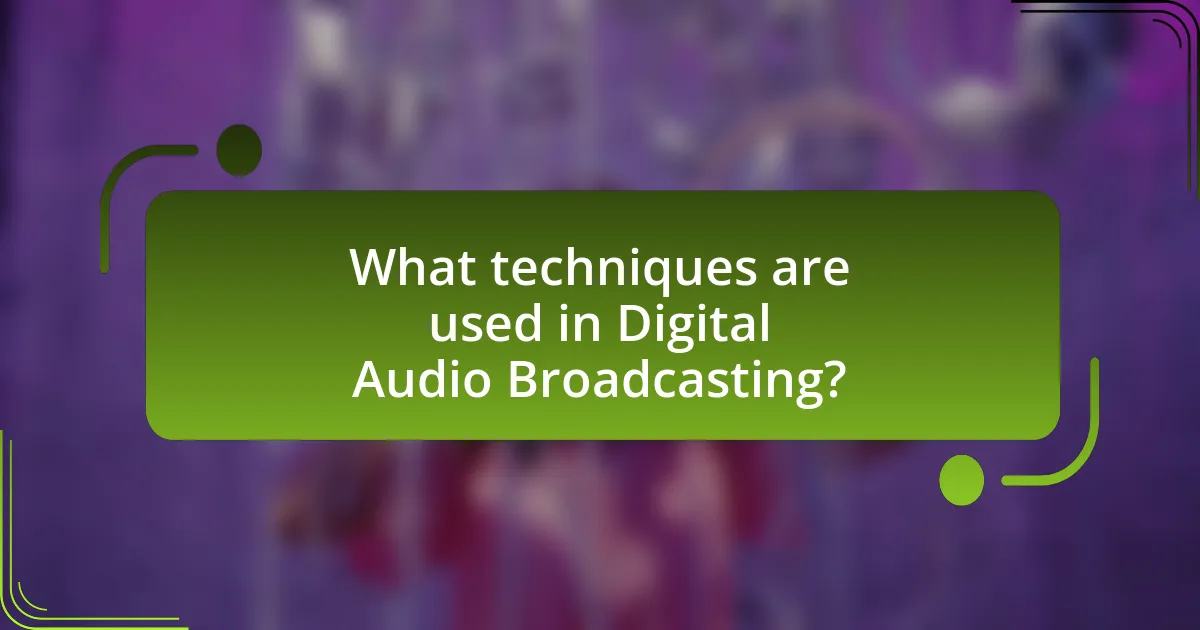
What techniques are used in Digital Audio Broadcasting?
Digital Audio Broadcasting (DAB) employs several key techniques, including the use of MPEG Audio Layer II compression, error correction coding, and multiplexing. MPEG Audio Layer II compression reduces the data rate while maintaining audio quality, allowing for efficient transmission. Error correction coding, such as Reed-Solomon coding, enhances signal reliability by detecting and correcting errors during transmission. Multiplexing enables multiple audio channels to be transmitted simultaneously over a single frequency, optimizing bandwidth usage. These techniques collectively improve the efficiency, quality, and reliability of digital audio broadcasts.
How do encoding and compression techniques affect audio quality?
Encoding and compression techniques significantly impact audio quality by altering the fidelity and clarity of sound. Lossy compression methods, such as MP3, reduce file size by removing audio data deemed less critical, which can lead to a noticeable decrease in sound quality, particularly in high frequencies. For instance, studies indicate that compression rates above 192 kbps can result in perceptible audio artifacts, affecting listener experience. Conversely, lossless compression formats like FLAC maintain original audio quality by preserving all data, ensuring that the sound remains true to the source. Therefore, the choice of encoding and compression directly influences the balance between file size and audio fidelity, with lossy formats often sacrificing quality for efficiency.
What are the most common audio codecs used in Digital Audio Broadcasting?
The most common audio codecs used in Digital Audio Broadcasting (DAB) are MPEG Audio Layer II (MP2), Advanced Audio Codec (AAC), and HE-AAC (High Efficiency AAC). MP2 has been widely adopted since the inception of DAB due to its efficient compression and sound quality, while AAC and HE-AAC offer improved compression rates and audio quality, making them suitable for modern broadcasting needs. These codecs are standardized in various DAB specifications, ensuring compatibility and optimal performance across different broadcasting platforms.
How does bitrate influence listener experience?
Bitrate significantly influences listener experience by determining the audio quality and clarity of the sound. Higher bitrates, such as 320 kbps, provide better sound fidelity, allowing listeners to perceive nuances in music, while lower bitrates, like 128 kbps, often result in compressed audio that can lose detail and introduce artifacts. Research indicates that listeners can distinguish between different bitrates, with studies showing that 70% of participants preferred higher bitrate audio when comparing the same track at varying bitrates. This preference is rooted in the ability to experience a fuller, richer sound, which enhances overall enjoyment and engagement with the audio content.
What are the challenges faced in implementing Digital Audio Broadcasting?
The challenges faced in implementing Digital Audio Broadcasting (DAB) include high infrastructure costs, limited coverage, and consumer acceptance issues. High infrastructure costs arise from the need for new transmitters and equipment to support DAB technology, which can be a significant financial burden for broadcasters. Limited coverage is another challenge, as DAB signals may not reach rural or remote areas effectively, leading to uneven service availability. Additionally, consumer acceptance issues stem from the need for listeners to purchase new DAB-compatible receivers, which can hinder widespread adoption. These challenges have been documented in various studies, including the European Commission’s report on the transition to digital broadcasting, which highlights the financial and technical barriers faced by broadcasters in different regions.
What technical hurdles must be overcome for widespread adoption?
Widespread adoption of digital audio broadcasting faces several technical hurdles, including the need for improved signal coverage, compatibility with existing devices, and the development of robust compression algorithms. Signal coverage is critical, as many regions still lack adequate infrastructure to support digital signals, which can lead to inconsistent audio quality and listener frustration. Compatibility issues arise because many consumers still use analog devices, necessitating a transition strategy that ensures seamless integration with current technology. Additionally, efficient compression algorithms are essential to optimize bandwidth usage without sacrificing audio quality, as evidenced by the challenges faced in the transition from analog to digital formats in various broadcasting sectors. These hurdles must be addressed to facilitate a smoother transition and enhance user experience in digital audio broadcasting.
How do regulatory issues impact Digital Audio Broadcasting?
Regulatory issues significantly impact Digital Audio Broadcasting (DAB) by shaping the operational framework within which broadcasters must function. These regulations dictate technical standards, licensing requirements, and content guidelines, which directly influence the deployment and accessibility of DAB services. For instance, the European Union’s regulatory framework mandates specific technical standards for DAB transmission, ensuring compatibility and quality across member states. Additionally, licensing regulations can limit the number of broadcasters in a given area, affecting competition and diversity in programming. Such regulatory measures are essential for maintaining broadcast quality and protecting consumer interests, as evidenced by the successful implementation of DAB in countries like the UK, where regulatory support has facilitated widespread adoption and innovation in digital broadcasting.
What innovations are on the horizon for Digital Audio Broadcasting?
Innovations on the horizon for Digital Audio Broadcasting (DAB) include enhanced audio quality through advanced compression techniques, improved data services for listeners, and the integration of hybrid broadcasting that combines traditional radio with internet streaming. These advancements aim to provide clearer sound and more interactive content. For instance, the adoption of the AAC codec is expected to enhance audio fidelity while reducing bandwidth usage, making broadcasts more efficient. Additionally, the implementation of DAB+ technology allows for more channels and better reception, which is already being adopted in various countries, demonstrating its effectiveness in improving listener experience.
How might artificial intelligence enhance audio broadcasting techniques?
Artificial intelligence can enhance audio broadcasting techniques by enabling personalized content delivery and improving audio quality through advanced processing algorithms. AI algorithms analyze listener preferences and behaviors, allowing broadcasters to tailor programming to individual tastes, which can increase listener engagement and satisfaction. Additionally, AI-driven tools can automatically adjust audio levels, reduce background noise, and enhance clarity, resulting in a more professional sound quality. For instance, AI technologies like machine learning and natural language processing are already being utilized in platforms such as Spotify and Apple Music to curate playlists based on user data, demonstrating the effectiveness of AI in enhancing the audio broadcasting experience.
What future technologies could revolutionize Digital Audio Broadcasting?
Future technologies that could revolutionize Digital Audio Broadcasting include 5G networks, artificial intelligence, and immersive audio formats like spatial audio. 5G networks will enable higher data rates and lower latency, allowing for seamless streaming and enhanced audio quality. Artificial intelligence can personalize content delivery and improve user engagement through smart recommendations and automated content curation. Immersive audio formats, such as spatial audio, provide a more engaging listening experience by simulating a three-dimensional sound environment, which can transform how audiences interact with audio content. These advancements are supported by ongoing developments in telecommunications and audio technology, indicating a significant shift in the landscape of digital audio broadcasting.
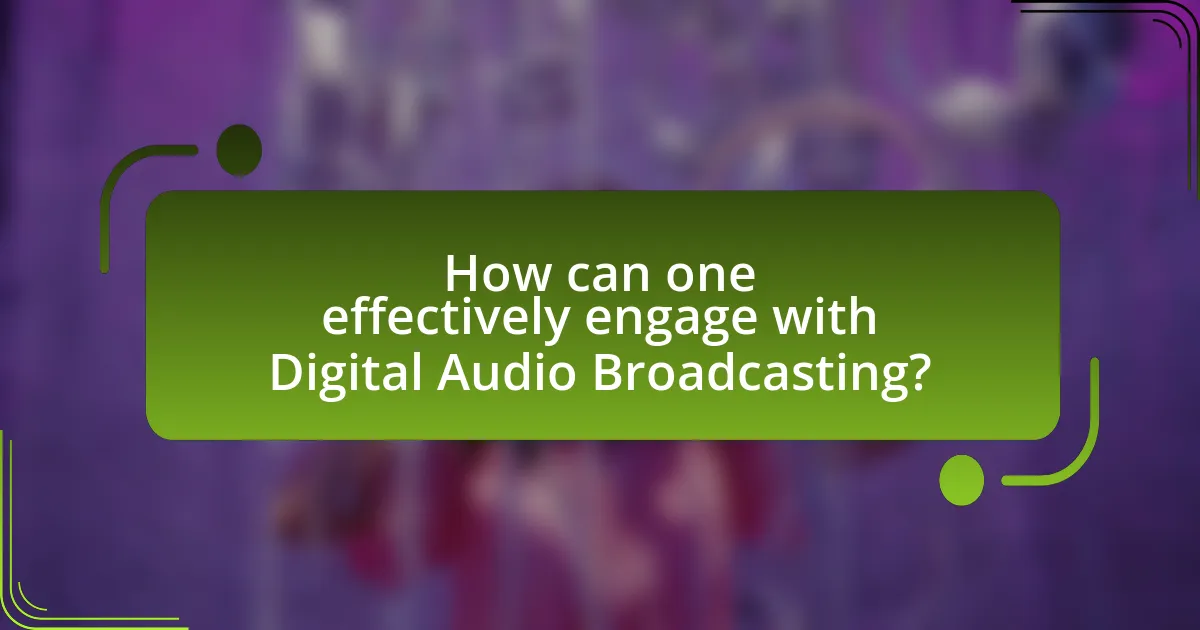
How can one effectively engage with Digital Audio Broadcasting?
To effectively engage with Digital Audio Broadcasting (DAB), one should utilize compatible devices and platforms that support DAB signals, ensuring access to a wide range of channels and content. Engaging with DAB involves using DAB radios, smartphones with DAB capabilities, or internet streaming services that offer DAB content. According to the Digital Radio Report 2022 by Ofcom, DAB listening has increased significantly, with over 60% of radio listening in the UK now through digital platforms, highlighting the growing importance of DAB in the audio broadcasting landscape.
What best practices should broadcasters follow for successful implementation?
Broadcasters should prioritize audience engagement, content quality, and technological integration for successful implementation. Engaging with the audience through interactive platforms enhances listener loyalty and feedback, which is crucial for content improvement. High-quality content, including well-produced audio and relevant programming, attracts and retains listeners, as evidenced by studies showing that 70% of listeners prefer stations with consistent quality. Additionally, integrating advanced technologies, such as streaming services and mobile applications, allows broadcasters to reach wider audiences and adapt to changing consumption habits, with over 50% of listeners now accessing audio content via digital platforms. These best practices collectively contribute to a broadcaster’s success in the evolving landscape of digital audio broadcasting.
How can audience engagement be maximized through Digital Audio Broadcasting?
Audience engagement can be maximized through Digital Audio Broadcasting by utilizing interactive features such as real-time listener feedback, personalized content, and targeted advertising. These features encourage active participation and foster a sense of community among listeners. For instance, platforms that allow listeners to vote on song selections or participate in live discussions create an interactive environment that enhances engagement. Additionally, personalized content based on listener preferences can increase relevance and satisfaction, leading to higher retention rates. Research indicates that personalized experiences can boost listener loyalty by up to 30%, demonstrating the effectiveness of these strategies in enhancing audience engagement.
What strategies can be employed to ensure high-quality audio delivery?
To ensure high-quality audio delivery, employing strategies such as utilizing high-bitrate encoding, optimizing audio equipment, and implementing effective signal processing techniques is essential. High-bitrate encoding minimizes compression artifacts, preserving audio fidelity; for instance, streaming services often use bitrates of 256 kbps or higher for optimal sound quality. Optimizing audio equipment, including microphones and speakers, ensures accurate sound reproduction, while effective signal processing techniques, such as equalization and dynamic range compression, enhance clarity and balance in audio output. These strategies collectively contribute to a superior listening experience in digital audio broadcasting.
What common troubleshooting tips exist for Digital Audio Broadcasting?
Common troubleshooting tips for Digital Audio Broadcasting include checking signal strength, ensuring proper antenna alignment, verifying equipment connections, and updating software or firmware. Signal strength can be assessed using a signal meter, which helps identify weak areas that may require antenna repositioning. Proper connections between the transmitter and receiver are crucial; loose or damaged cables can lead to audio dropouts. Additionally, keeping software and firmware up to date ensures compatibility and optimal performance, as outdated systems may encounter bugs or inefficiencies. These practices are essential for maintaining a reliable Digital Audio Broadcasting experience.
How can signal interference be minimized in Digital Audio Broadcasting?
Signal interference in Digital Audio Broadcasting can be minimized through the implementation of robust error correction techniques and the use of frequency diversity. Error correction methods, such as Reed-Solomon coding, enhance the integrity of the transmitted signal by detecting and correcting errors that occur during transmission. Frequency diversity involves transmitting the same signal over multiple frequencies, which reduces the likelihood of interference affecting the entire broadcast. Studies have shown that these techniques significantly improve signal quality and listener experience, as evidenced by the successful deployment of DAB systems in various countries, which report lower interference levels compared to traditional analog broadcasting.
What steps can be taken to resolve audio quality issues?
To resolve audio quality issues, one should first assess the audio source and equipment used. Ensuring that high-quality microphones and audio interfaces are utilized can significantly enhance sound clarity. Additionally, checking the recording environment for background noise and optimizing acoustics can improve audio fidelity. Implementing proper audio compression and equalization techniques during post-production can further refine sound quality. Research indicates that using a sample rate of at least 44.1 kHz and a bit depth of 16 bits can help maintain audio integrity, as these settings are standard for high-quality digital audio.
